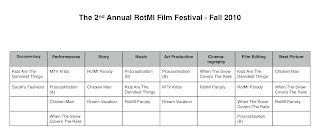The test will focus on Spike Lee’s Do The Right Thing, Alfred Hitchcock’s North By Northwest, the Student Choice Film for our specific class, and the key terms and concepts from chapter 2 of our textbook, Understanding Movies. Also, review everything from the beginning of the course, such as literary, dramatic, and cinematic elements, etc. Be sure to look over your notes, your homework assignments, and all Viewing Guides and handouts.
- In Do The Right Thing: title credits; match cut; breaking the fourth wall; montage; allusion; litany; episodic story structure; racial tensions in NYC; Spike Lee's DVD Special Features. Be able to cite specific examples of these concepts from the film to prove your point.
- In North By Northwest: director's cameo; day for night shooting; rear screen projection effect; femme fatale; MacGuffin; final cut privileges; title credits; parody; montage; characterization & compression; visual irony; phallic symbol; visual foreshadowing; aural cue; character subtext; "stealing a shot"; film subtexts; "Becoming George Kaplan"; "The Matchless Eve Kendall"; "Murder scenes shot lovingly & love scenes shot murderously"; epiphany & character arc; how tension & suspense are created in "The Crop Dusting Scene." Be able to cite specific examples of these concepts from the film to prove your point
- PERIOD 2 STUDENT CHOICE FILM - In Peter Weir’s The Truman Show: product placement; Christof as God figure; allegory; film style; story structure; character arc; major themes (ex. free will vs. determinism); DVD Special Features
- PERIOD 8 STUDENT CHOICE FILM - In Paul Haggis’s Crash: eye of God shot; match cut; web of life plot; A. O. Scott’s original NYT review
- From Understanding Movies: (Ch. 2) Mise en scene ("placing on stage"), aspect ratio (standard vs. widescreen), iris shot, the dominant, subsidiary contrasts, intrinsic interest, tight vs. loose framing, character placement, composition, proxemic patterns, open vs. closed form.
This is only a general guide and not a complete list of everything we learned and everything you should study!
Extra Help will be offered on Monday, 12/19 at 2:40 in Rm. 452.
The approximate test breakdown: 40% multiple choice / 20% miss en scene analysis / 40% short answers
















